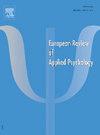荷兰某大学留学生职业倦怠评估工具的有效性研究
IF 1.4
4区 心理学
Q3 PSYCHOLOGY, APPLIED
European Review of Applied Psychology-Revue Europeenne De Psychologie Appliquee
Pub Date : 2025-09-01
DOI:10.1016/j.erap.2025.101079
引用次数: 0
摘要
倦怠影响大学生的学习成绩和学业承诺。因此,必须有一种最新的、心理计量学上健全的仪器来检测倦怠症状。虽然开发了一种新的有效可靠的工具,即职业倦怠评估工具(BAT),但目前还没有确定BAT是否可以分别在荷兰语和英语中与荷兰和国际大学生一起使用。目的验证荷兰语版和英语版的大学生健康评估量表。具体地说,心理测量的性质,析因结构,测量工具在荷兰和国际学生群体的不变性进行了检查。方法以荷兰某大学991名学生为研究对象。信度采用Cronbach 's alpha进行评估,而收敛效度和判别效度则通过检查与其他措施的相关性来评估。为了评估BAT的因子效度,采用多组验证性因子分析(MGCFA)。此外,测量不变性进行了测试,以确保该工具在荷兰和国际学生之间的可比性。结果BAT具有较高的信度和较好的收敛效度和判别效度。MGCFA支持二阶阶乘模型,而测量不变性表明该工具可用于比较荷兰和国际学生。结论本研究结果表明,BAT是评估荷兰和国际学生职业倦怠症状的可靠工具。该仪器可以帮助早期发现倦怠症状,最终有助于提高学生的幸福感和学习成绩。本文章由计算机程序翻译,如有差异,请以英文原文为准。
Validation of the Burnout Assessment Tool among (inter)national students from a Dutch university
Introduction
Burnout impacts academic performance and commitment of university students. It is therefore essential to have an up-to-date and psychometrically sound instrument for detecting burnout symptoms. Although a new valid and reliable instrument, namely the Burnout Assessment Tool (BAT), was developed for workers, it has not yet been established whether the BAT can be used in Dutch and English with Dutch and international university students, respectively.
Objective
This study aimed to validate the Dutch and English versions of the BAT for university students. Specifically, the psychometric properties, factorial structure, and measurement invariance of the tool across Dutch and international student populations were examined.
Method
The participants were 991 students from a Dutch university. Reliability was assessed using Cronbach’s alpha, while convergent and discriminant validity were evaluated by examining correlations with other measures. To assess the factorial validity of the BAT, Multi-group Confirmatory Factor Analysis (MGCFA) was employed. Moreover, measurement invariance was tested to ensure comparability of the tool across Dutch and international students.
Results
The BAT demonstrated high reliability and good convergent and discriminant validity. The MGCFA supported a second-order factorial model, while measurement invariance indicated that the instrument can be used comparably across Dutch and international students.
Conclusion
The findings of the current study suggest that the BAT is a reliable tool for assessing burnout symptoms among both Dutch and international students. The instrument can help in the early detection of burnout symptoms, ultimately contributing to improved student well-being and academic performance.
求助全文
通过发布文献求助,成功后即可免费获取论文全文。
去求助
来源期刊

European Review of Applied Psychology-Revue Europeenne De Psychologie Appliquee
PSYCHOLOGY, APPLIED-
CiteScore
2.20
自引率
20.00%
发文量
38
期刊介绍:
The aim of the Revue européenne de Psychologie appliquée / European Review of Applied Psychology is to promote high-quality applications of psychology to all areas of specialization, and to foster exchange among researchers and professionals. Its policy is to attract a wide range of contributions, including empirical research, overviews of target issues, case studies, descriptions of instruments for research and diagnosis, and theoretical work related to applied psychology. In all cases, authors will refer to published and verificable facts, whether established in the study being reported or in earlier publications.
 求助内容:
求助内容: 应助结果提醒方式:
应助结果提醒方式:


